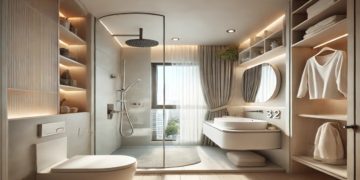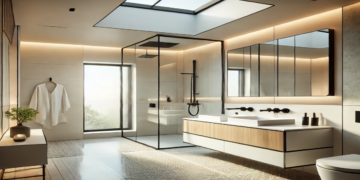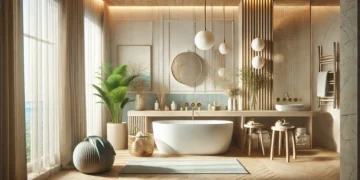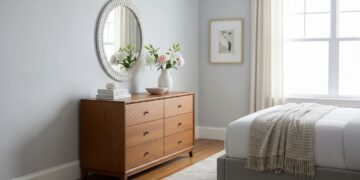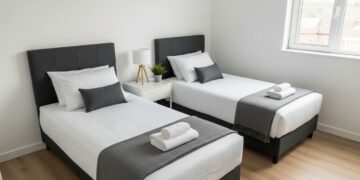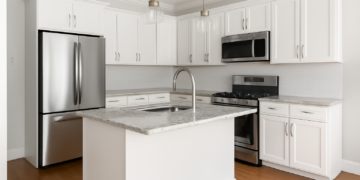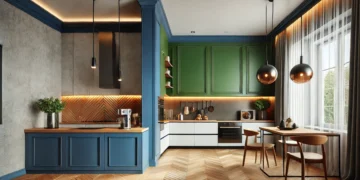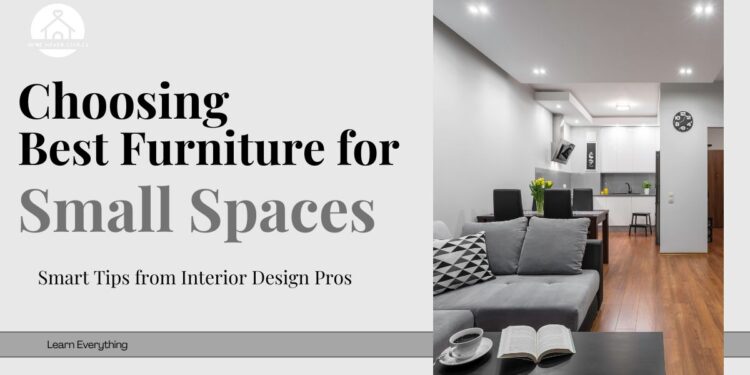When you’re working with limited square footage, every design choice you make has a major impact. The key is not just choosing beautiful pieces but ensuring that every item in your home is intentional, multi-functional, and perfectly suited to your space. Whether you’re furnishing a studio apartment or a cozy room in a larger house, choosing the appropriate furniture for small spaces can make all the difference, transforming a tight area into a pleasant, highly functional, and stylish sanctuary. For more ideas on how to create a festive atmosphere in smaller spaces, explore our other guides.
The good news is that even the smallest homes can become well-designed havens with a few innovative strategies and the right clever furniture for small spaces. To help you maximize every square inch, we’ve broken down the essential principles and tips for selecting the best furniture for a compact home.
The Golden Rules of Small-Space Furniture
Before you start shopping for specific pieces, it’s crucial to understand the fundamental principles that interior designers use to make a room feel more spacious and open.
1. Prioritize Scale and Proportion
 The biggest mistake people make is choosing furniture that is out of proportion with the room. A large, bulky sofa will overwhelm a small living room, making it feel cramped and unbalanced.
The biggest mistake people make is choosing furniture that is out of proportion with the room. A large, bulky sofa will overwhelm a small living room, making it feel cramped and unbalanced.
-
Start with Measurements: Before you buy anything, measure your room’s length, width, and ceiling height. Use painter’s tape to map out where each piece of furniture will go on the floor.
-
Create Visual Balance: Pair larger items with pieces that have a lighter “visual weight.” For example, a solid sofa can be balanced with a glass or acrylic coffee table that takes up no visual space.
-
Go Vertical: Draw the eye upward with tall, slim bookshelves or floor-to-ceiling curtains. This trick makes the room feel taller and more expansive.
2. Ensure Good Traffic Flow
 Traffic flow, or the pathways people take to move through a room, is vital for creating a functional and comfortable space. A well-designed room should feel easy to navigate, not like an obstacle course. For more general advice on arranging furniture, check out our guide on 25 living room layout ideas.
Traffic flow, or the pathways people take to move through a room, is vital for creating a functional and comfortable space. A well-designed room should feel easy to navigate, not like an obstacle course. For more general advice on arranging furniture, check out our guide on 25 living room layout ideas.
-
Clear Pathways: Leave at least 30 inches of space for walkways. For high-traffic areas, aim for 36 inches to allow two people to pass comfortably.
-
Float Your Furniture: Avoid pushing all furniture against the walls. Pulling key pieces, like a sofa, a few inches away from the wall creates a sense of openness and “breathing room,” making the space feel larger than it is.
7 Smart Tips for Choosing Furniture for Tight Spaces
Once you have your floor plan and proportions in mind, you can begin to select the best furniture for tight spaces. For specific ideas on how to furnish a long, narrow living room, we have a dedicated guide.
1. Invest in Multifunctional Furniture Ideas
 The number one rule for small homes is to make every piece of furniture count. Choose items that serve multiple purposes.
The number one rule for small homes is to make every piece of furniture count. Choose items that serve multiple purposes.
-
Storage Ottoman: An ottoman can serve as a footrest, extra seating, or a coffee table while providing hidden storage for blankets, remotes, or magazines.
-
Sofa Beds: A quality sleeper sofa is a fantastic piece of clever furniture for small spaces, allowing a living room to double as a guest bedroom in a pinch.
-
Nesting Tables: These sets of tables can be used individually as needed and neatly tucked away when not in use.
2. Embrace Built-In Storage
 Clutter is the enemy of small spaces. The most effective furniture ideas for small spaces are those that help keep mess under control.
Clutter is the enemy of small spaces. The most effective furniture ideas for small spaces are those that help keep mess under control.
-
Beds with Drawers: A bed with built-in drawers is a perfect place to store clothing, bedding, or other goods, eliminating the need for a separate dresser. For more ideas on how to fit two beds into a compact bedroom, check out our guide.
-
Coffee Tables with Storage: A lift-top coffee table with secret compartments is ideal for keeping your living room organized and tidy.
-
Storage Benches: A bench in an entryway can provide both seating for putting on shoes and a hidden spot for bags, shoes, and other essentials.
3. Go for Flexible and Modular Designs
 Modular furniture can be quickly rearranged to suit your needs, providing flexibility and adaptability.
Modular furniture can be quickly rearranged to suit your needs, providing flexibility and adaptability.
-
Modular Sofas: A sectional sofa with modular components allows you to reconfigure the seating depending on the occasion, whether you’re hosting guests or simply relaxing.
-
Drop-Leaf Tables: An expandable dining table that can be adjusted to seat more guests is a great solution for a small dining room that needs to adapt from daily use to special occasions.
4. Choose Pieces with Exposed Legs
 Furniture with tall, skinny legs creates a sense of openness by allowing light and air to pass underneath. A sofa with a visible base, for example, makes the floor plan feel less obstructed and more expansive. This simple visual trick makes the room feel airier and larger.
Furniture with tall, skinny legs creates a sense of openness by allowing light and air to pass underneath. A sofa with a visible base, for example, makes the floor plan feel less obstructed and more expansive. This simple visual trick makes the room feel airier and larger.
5. Pick the Right Sofa Size
 When shopping for a sofa, don’t just look at its length. Pay attention to the armrests. A loveseat or a small sofa with thin, skinny arms provides the same amount of sitting space as a bulkier couch but uses far less floor space.
When shopping for a sofa, don’t just look at its length. Pay attention to the armrests. A loveseat or a small sofa with thin, skinny arms provides the same amount of sitting space as a bulkier couch but uses far less floor space.
6. Match Furniture with Your Walls
 While you don’t have to go with a neutral color palette, using a monochromatic scheme creates a cohesive look that makes a small area feel bigger. When a sofa in a deep navy hue is placed against a matching midnight blue wall, it blends in rather than stands out, making the space seem endless. For more dramatic bold color ideas, we have a dedicated guide.
While you don’t have to go with a neutral color palette, using a monochromatic scheme creates a cohesive look that makes a small area feel bigger. When a sofa in a deep navy hue is placed against a matching midnight blue wall, it blends in rather than stands out, making the space seem endless. For more dramatic bold color ideas, we have a dedicated guide.
7. Use Mirrors Strategically

Mirrors are a designer’s secret weapon for making a room appear larger. They reflect light and create the illusion of depth, making a room feel twice its size. Place a large mirror opposite a window to maximize natural light and create an even greater sense of space. For more creative ideas, check out our guide to small bathroom lighting.
Conclusion
By embracing smart design principles and making intentional choices, you can turn any compact home into a functional and stylish haven. Choosing the right furniture for limited space is all about prioritizing scale, multi-functionality, and clever storage solutions. With these expert tips, you can create a home that is not only organized and comfortable but also a joy to live in. For more inspiration on creating a personalized sanctuary, remember to check out our other home decor guides.
FAQs: More Insights on Choosing Small Furniture Pieces
Q: What type of furniture is best for a small apartment?
A: The best furniture for a small apartment is clever, hard-working, and multifunctional. Look for items that serve at least two purposes, such as a sofa bed for guests, a storage ottoman, or a console table that can also be used as a home office desk when needed.
Q: Why is it important to consider furniture scale?
A: Considering the scale and proportion of your furniture ensures it fits your room’s size without overwhelming the space. Using items with the right measurements prevents the area from feeling crowded and helps you maintain good traffic flow, making your home more comfortable and inviting.
Q: Does matching furniture to the walls make a room look bigger?
A: Yes, it does. By matching your furniture to the wall color, you reduce visual breaks and create a seamless, cohesive look. This trick can make the space feel more open and continuous, giving the illusion of a larger room.
Q: What is the most important thing to remember when buying furniture for small spaces?
A: The single most important rule is to avoid clutter and ensure that every item has a purpose. Prioritize quality over quantity and choose pieces that help you stay organized and make the most of your available floor plan. This will help you create a cozy aesthetic that is both practical and beautiful.



